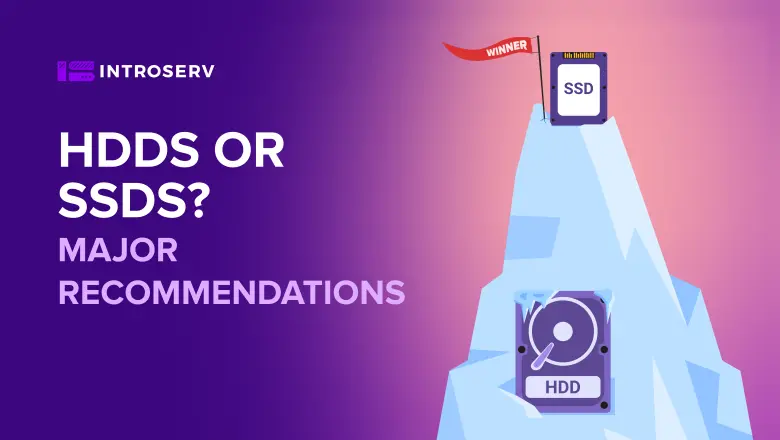
HDDs or SSDs
If you rent a server for important services, you are most likely to be concerned about both data security and storage reliability. Performance, duty cycles, average uptime, and rotational vibration are generally the things you are interested in when evaluating hard drives.
To ensure data security, these criteria must be met prior to making equipment available to customers. The performance and cost of these HDDs and SSDs vary based on specific offerings.
Listed below are the capabilities of these devices:
Quick Overview
Hard disk drives (HDDs) and solid-state drives (SSDs) come in several variants and are designed to meet the needs of different customers. Such equipment includes:
- SAS, Value SAS and SATA SSDs: fast, random-access storage devices;
- SAS 10K and 15K hard drives: these drives offer performance-optimized application availability;
- 7.2K SAS and SATA hard drives: these drives have higher capacity and unique cost-per-gigabyte for capacity-optimized applications;
- Data entry hard drives: The lowest-cost drives are used in low-utilization applications with an unlimited total number of drives; due to the limitations imposed on their use, these drives are only found in a handful of systems and configurations.
Hard Drive Recommendations
- Enterprise server and storage hard drives are available in several options, including Mission Critical (10K and 15K) and Mission Critical (7.2K) performance-optimized capacity-optimized systems (Mission Critical and Business Critical, respectively).
Mission Critical (MC) drives, or performance-optimized drives (SAS 10K and 15K), are used in applications requiring maximum reliability and performance. Available in 2.5'' form factor only. Business Critical (BC), or capacity-optimized drives (Nearline SAS and SATA 7.2K), provide more capacity to users, but are less reliable and performant than Mission Critical. They are available in two form factors, 2.5'' and 3.5''.
- There are fundamental trends in the hard drive industry. The standard basic data block size (disk sector) is now increasingly 4K bytes instead of 512 bytes. However it is possible to keep the previous 512 byte sector size, so both formats will be available in the future. Below is some important information for the user.
- In late 2009, hard disk drive manufacturers began moving away from the traditional 512 byte sector format. In 2010, this shift accelerated and became mainstream in 2011. As a result of 4K technology, the 4096 bytes format became more efficient. Today, it is referred to as IDEMA's "Extended Format". Enterprise hard drives are also being converted to this technology, but implementation will be slow. The first "Extended Format" enterprise hard drive became available in 2012. A limited number of these products appeared in 2013, but their general proliferation only began in 2014.
- For decades, customers have used applications, operating systems, and file systems on a 512-byte basis (512n). The transition to 4K technology will affect these software systems and will require additional testing, as well as possible structural changes to the software. New higher-capacity 4K drives will need to be created. Since customers may be reluctant to adopt this new technology, an emulation model of such disks has been developed. The technology is based on 4K, but can address and transmit data over an interface with 512 bytes.
- A table with the digital characteristics of this concept can be found below:
Format type |
Byte per sector |
Bytes per physical sector |
512n |
512 |
512 |
512e |
512 |
4096 |
4Kn |
4096 |
4096 |
Many configurations of modern computing systems continue to treat 512 bytes as a fixed sector size. There are three types of drives: 512n, 512e and 4K. The 512n format is available to customers who wish to use the same drive type as before. 512e drives provide a 512 byte sector for capacities not available in the 512n drive. 4K devices are designed for customers who are ready to accept new higher capacity drives, as well as for those who expect future innovation in the industry.
Keep in mind that 512-byte/sector addressing technology will continue to evolve over the course of the next several decades. The number of drives formatted in 4Kn will remain small and the latest maximum capacity hard drives will be available in 512e sector format.
Performance-enhanced 512e hard drives: 13G and 14G technology offerings
In early 2017, 900GB 15K 512e 12Gbps SAS hard drives were introduced in 2.5' form factors. As part of the updated product, an enhanced cache feature was added to improve readability in addition to the Advance Write Cache.
Seagate Inc.'s TurboBoost™ advanced cache technology was the most significant improvement to the standard enterprise hard drive design (10K RPM and 15K RPM). This new 512e drive incorporates a small amount of eMLC NAND memory as a cache, which reduces latency and dramatically improves response times, making it predictable.
Rather than simply constructing storage systems using a "mix" of discrete HDDs and SSDs, the makers of TurboBoost technology have unlocked the strengths of both HDDs and SSDs.
Hot data is copied from magnetic media to the NAND cache. A host can request this information from flash memory much more quickly than from a spinning magnetic disk/carrier. As the cache fills up, less-used files are removed from the NAND to make room for new data, while the original files appear on the disk media. By utilizing TurboBoost technology, search and waiting times are often eliminated from the familiar reading process. With constant storage in NAND, there will be no rotating media to navigate.
The higher the workload, the greater the benefit of optimized caching in hard drives. This technology is ideal for building new high-performance servers, operational management of multiple transactions or quick swaps (the feature stays active all the time and does not require host permission).
- Virtual desktop infrastructure
- Operational transaction processing
- Web servers
- Small database queries
- Exchange workloads
- Random read/write tasks
For detailed information on performance results for various drive capacities, please refer to the comparative specifications document.
SSD recommendations
The following categories of EMC enterprise SSDs:
- Write Intensive (WI) - 50/50 read/write loads with maximum life expectancy; recommended for high-performance computing, database logging, and caching workloads.
- Mix Use (MU) - 70/30 read/write loads at medium life; recommended for email, transactional processing, and e-commerce workloads.
- Read Intensive (RI) - 90/10 read/write loads with lower lifetime; recommended for database storage, multimedia transfer, and VOD loads;
- Boot Optimized (Boot) - Low-cost, low-life, low-capacity SSDs used as boot devices on servers, suitable for all types of workloads.
Main interface - EMC SSDs are compatible with the following devices:
- SATA SSD, SATA SSDs are based on the standard SATA interface; they provide reasonable performance for enterprise applications where the focus is put not on efficiency, but rather on ways to reduce costs.
- Value SAS SSD are developed by Toshiba Memory Corporation. These are a new class of SAS drives that leverage the PowerEdge SAS server infrastructure and provide better performance, latency and reliability than standard SAS SSDs at a comparable price. They cost less than standard SAS drives and have lower performance, which puts them between SATA and standard SAS. Value SAS can be an easy replacement for SATA SSDs and can provide high value for most enterprise applications.
- SAS SSD is based on the standard SAS interface; these drives offer ultra-high reliability, data integrity and data recovery which makes them more suitable than SATA SSDs and Value SAS SSDs for applications that require the maximum performance from SAS/SATA drives. They cost more, but still offer the standard quality of SAS SSD technology.
- PCIe SSD: PCIe SSDs are high-performance solid-state storage devices that deliver up to 2,000 times the IOPS of traditional spinning hard disks.








